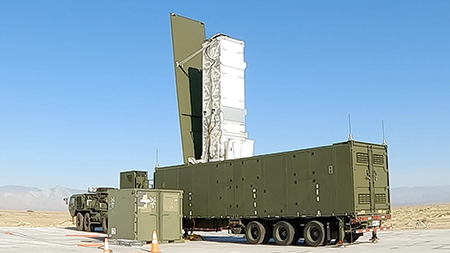Russia Cancels Intermediate-Range Missile Moratorium
September 2025
By Xiaodon Liang
Russia will cease abiding by its unilateral moratorium on the deployment of ground-launched intermediate-range missiles, six years after its president, Vladimir Putin, first announced the measure and invited the United States to reciprocate following U.S. withdrawal from the Intermediate-Range Nuclear Forces (INF) Treaty in 2019.

The United States and its NATO allies almost immediately rejected the offer on the grounds that Russia already had deployed missiles barred by the INF Treaty in violation of its own moratorium. But in a later exchange of proposals in December 2021 and January 2022, Washington indicated its willingness to begin new discussions with Russia on restrictions on the deployment of ground-launched intermediate and medium-range missiles. (See ACT, March 2022.)
As originally formulated by Putin in 2019, the unilateral moratorium bound Russia not to deploy previously barred INF-range missiles in “any given region until U.S.-made intermediate-range and shorter-range missiles are deployed there.” The variant offered by Russia as a proposed agreement in December 2021 instead suggested that the United States and Russia not deploy the missiles “either outside their national territories or inside their national territories from which the missiles can strike the national territory of the other party.”
Russia’s recent abandonment of its moratorium was announced Aug. 4 by the Russian Foreign Affairs Ministry in a statement observing that the United States had “made significant progress in the practical implementation [of ] … openly declared plans to deploy U.S. ground-launched INF-range missiles in various regions.”
In April, Russian Deputy Foreign Minister Sergei Ryabkov said deployment of U.S. missiles in Europe and Asia would trigger a withdrawal of the moratorium offer. At the time, the U.S. Army was deploying its “Typhon” Mid-Range Capability ground-launched missile system to the Philippines for exercises. (See ACT, May 2024.)
The Aug. 4 statement notes the Philippine deployment, as well as the recent participation by Typhon-equipped troops in multinational exercises in Australia in July.
The Typhon integrates a variant of the Mk-41 vertical launch system (VLS)—a standardized launcher aboard many U.S. and allied naval vessels that is capable of supporting numerous types of missiles—with supporting ground equipment. The Russian statement also noted a second derivative of the Mk-41 VLS, the Mk-70 Mod 1 Payload Delivery System.
The Mk-70, a containerized variant of the Mk-41 VLS launcher, was deployed by the U.S. Navy in a September 2023 exercise to the Danish island of Bornholm. In December 2024, the Navy announced that many littoral combat ships would be equipped with Mk-70 containers.
By design, both the Typhon and the Mk-70 are capable of launching the Tomahawk medium-range cruise missile. In a ground-launched configuration, this missile would have been banned by the now-defunct INF Treaty, which eliminated all Russian and U.S. ground-launched missiles with medium and intermediate ranges between 500 and 5,500 kilometers
German Defense Minister Boris Pistorius announced July 14 that Berlin had informed Washington of its interest in purchasing Typhon missile launchers for the German armed forces. He said that Washington is reviewing a U.S.-German agreement announced last year, whereby the United States would deploy its own Typhon-equipped forces in Germany along with the new Long-range Hypersonic Weapon (LRHW), Reuters reported. The LRHW made its first foreign deployment, to Australia in July.
The U.S. military has not yet test-launched a Tomahawk missile from a Mk-70, although the containerized launcher’s commonality with the Mk-41 strongly suggests it would be capable of supporting the cruise missile. Manufacturer Lockheed Martin describes the containerized launcher as providing “mid-range precision fires capabilities.”
The U.S. Army’s Rapid Capabilities and Critical Technologies Office, which led the development of the Typhon system, issued a solicitation for a third mobile Tomahawk-launcher design. In a June 27 contracting notice, the office described its interest in acquiring four prototypes of a Common Autonomous Multi-Domain Launcher, Heavy for the medium-range cruise missile. The Marine Corps is also pursuing integration of Tomahawk launchers with ground vehicles.
The Russian statement also highlighted concerns with the U.S. Precision Strike Missile (PrSM), which was tested to a range beyond its original design maximum of 499 kilometers in October 2021. The PrSM is a replacement for the Army Tactical Missile System and is designed to be fired from the M142 High Mobility Artillery Rocket System (HIMARS) launcher.
The Russian statement observed that, under the terms of the now-defunct INF treaty, the use of HIMARS to test PrSM means that all HIMARS launchers would fall under the treaty’s prohibitions.
Russia has been expanding its own arsenal of intermediate-range weapons, beyond the 9M729 cruise missile which originally triggered U.S. withdrawal from the INF Treaty. (See ACT, January/February 2019.) The Wall Street Journal reported in 2019 that the United States had informed allies that four battalions of the 9M729 missile had been deployed, and open-source analysis by the Federation of American Scientists indicate it is possible that since then, Russia has constituted a fifth battalion.
In October 2020, Putin suggested an exchange of inspections accompanying the moratorium to verify that the 9M729 missile was not deployed in the Russian exclave of Kaliningrad. In return, he requested inspections of Aegis Ashore missile defense launchers in Romania and Poland to confirm that they are incapable of firing offensive missiles. (See ACT, November 2020.) Before withdrawing from strategic stability talks with Russia in response to the full-scale invasion of Ukraine, the United States said it was willing to discuss transparency measures.
Speaking Aug. 1 on a visit to Belarus, Putin said serial production of the Oreshnik intermediate-range ballistic missile, first used in combat against Ukraine in November, had begun. His Belarusian counterpart, Alexander Lukashenko, said preparations for deployment of the new missile in Belarus would be completed this year, with deployments in 2026.
Belarus and Russia will conduct joint exercises in September to plan for the use of Oreshnik, Belarussian Defense Minister Viktor Khrenin said Aug. 13, according to Reuters. The two military forces also will conduct exercises on planning the use of nuclear weapons, the minister said.
